Web Application Hacking Security WAHS Course in Patna
Enroll now to transform your basic web application knowledge with the help of EC-Council WAHS Certification or Web Application Hacking Security facilitated by Craw Security’s high-end mentorship at Rohini’s state-of-the-art elevations. With the help of world-class training instructors with many years of authentic experience, Craw Security offers its immense qualitative training under the strict supervision of professional instructors. Become a person who is entirely responsible for handling web application hacking and security protocols with this Web Application Security Professional.
About the Web Application Hacking and Security (WAHS) Training in Delhi
Initially, Web Application Hacking Security has several challenges that are derived from the engrossing iLab ecosystems of EC-Council, right from the EC-Council CEH to the Certified Penetration Testing Professional (CPENT) Certification from Certified Application Security Engineer (CASE) .Net to Java. However, web application hacking security leads further to more intricate scenarios as you rise through every problem.
In addition, the Web Application Hacking Course is similar to CTF or Capture-The-Flag competitions that validate your hacking aptitudes. However, you can nicely maintain your pace by trying till you confirm your objective. In this regard, test your skills and work alone to control complex concerns or follow the trainer as they do a walkthrough to assist you in learning Certified Web Application Hacking Security (WAHS).
What is Web Application Hacking Security (WAHS)?
This highly affiliated training for Certified Web Application Security Professionals is the best one you can choose to learn Web Application Hacking Security certification right from the best cyber security training institute in India, and that is Craw Security. In this regard, EC-Council WAHS Certification or Web Application Hacking and Security is the best fit in the current market that is coming from the house of EC-Council.
Moreover, it is the only experiential program that furnishes extensive information and 100% hands-on learning. In addition, it helps many cybersecurity experts to understand, hack, test, and secure web applications from current and budding security threats. Subsequently, one can also learn about application vulnerabilities and web application hacking methodologies via this proactive program, highly developed and designed by numerous experts hailing from varied organizations all over the world.
Modules for Mobile Application Security Course in Patna
➜ Module 01: Advanced Web Application Penetration Testing
➜ Module 02: Advanced SQL Injection (SQLi)
➜ Module 03: Reflected, Stored, and DOM-based Cross-Site Scripting (XSS)
➜ Module 04: Cross-Site Request Forgery (CSRF) – GET and POST Methods
➜ Module 05: Server-Side Request Forgery (SSRF)
➜ Module 06: Security Misconfigurations
➜ Module 07: Directory Browsing/Bruteforcing
➜ Module 08: Network Scanning
➜ Module 09: Auth Bypass
➜ Module 10: Web App Enumeration
➜ Module 11: Dictionary Attack
➜ Module 12: Insecure Direct Object Reference Prevention (IDOR)
➜ Module 13: Broken Access Control
➜ Module 14: Local File Inclusion (LFI)
➜ Module 15: Remote File Inclusion (RFI)
➜ Module 16: Arbitrary File Download
➜ Module 17: Arbitrary File Upload
➜ Module 18: Using Components with Known Vulnerabilities
➜ Module 19: Command Injection
➜ Module 20: Remote Code Execution
➜ Module 21: File Tampering
➜ Module 22: Privilege Escalation
➜ Module 23: Log Poisoning
➜ Module 24: Weak SSL Ciphers
➜ Module 25: Cookie Modification
➜ Module 26: Source Code Analysis
➜ Module 27: HTTP Header modification
➜ Module 28: Session Fixation
➜ Module 29: Clickjacking
Job Opportunities After Web Application Hacking Security Program
As we can generally understand that this WAHS Certification comes from the house of EC-Council, which is a tech supergiant in the modern world, facilitating the world with many vendor-neutral cybersecurity programs and certifications. Hence, it is pretty sure that if a person completes this world-class training in Web Application Hacking Security from its accredited training partner – Craw Security, the same will not face difficulty in finding a maiden job at much sense.
Instead, there are many chances that the same would get placed before the one gets a hand on the certificate from EC-Council for the same course. Subsequently, as mentioned on the official website of the EC-Council, Penetration testers’ salaries range from $57,000 to $134,000, depending on the IT security analyst’s experience level.
Course Duration
➝ Course Level : Intermediate
➝ Language : English, Hindi
➝ Course Delivery : Classroom Training
➝ Include : Training & Certificate
➝ Course pdf : Click here to Download

Latest Student Reviews
Frequently Asked Question
About Web Application Hacking Security WAHS Course in Patna.
What is Web application security in cyber security?
Web application security is a branch of cyber security that focuses on protecting websites, web applications, and web services from malicious attacks. It is an important part of an organization’s overall security program and involves a comprehensive set of security measures designed to protect websites, web applications, web services, and their associated data from unauthorized access, misuse, and modification. These measures include input validation, output encoding, authentication, and authorization. Web application security also involves monitoring and testing to ensure that security measures are effective and up to date.
How do you secure Web applications?
By using the following protocols, anyone can save web applications from being compromised:
- Secure authentication
- Input validation
- Encrypt sensitive data
- Implement access control
- Use a web application firewall
- Monitor and log activity
- Perform regular security scans
What are web application vulnerabilities?
Web application vulnerabilities are security weaknesses commonly found in web applications, such as web browsers, web servers, and web services. These vulnerabilities can be exploited to gain unauthorized access to sensitive data, cause a denial of service, or perform malicious code injection. Common web application vulnerabilities include cross-site scripting (XSS), SQL injection, broken authentication, and insecure direct object references.
What are basic web application attacks?
Some basic web application attacks are as follows:
- SQL Injection
- Cross-Site Scripting (XSS)
- Cross-Site Request Forgery (CSRF)
- Buffer Overflows
- Malicious File Execution
- Password Attacks
- Privilege Escalation
What is the most common way web applications are hacked?
The most common way web applications are hacked through injection attacks, such as SQL injection. Injection attacks are used to gain access to a website’s database and potentially sensitive information. Other common web application hacking techniques include cross-site scripting (XSS), remote file inclusion (RFI), and cross-site request forgery (CSRF).
Why is Web application security important?
Web application security is important because it helps protect websites and the sensitive data stored on them from malicious attacks. These attacks can be devastating, causing financial losses, loss of customer trust, and reputational damage. Web application security can help to protect against malicious attacks, such as SQL injection, cross-site scripting, and session hijacking, as well as other types of threats. It is also important to ensure that websites are regularly updated to patch any security vulnerabilities.
